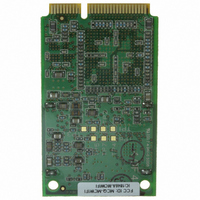101-1284 Rabbit Semiconductor, 101-1284 Datasheet - Page 39

101-1284
Manufacturer Part Number
101-1284
Description
DEV KIT STANDARD MINI RCM5600W
Manufacturer
Rabbit Semiconductor
Series
MiniCore™r
Type
Transceiver, 802.11 b/gr
Datasheet
1.101-1285.pdf
(130 pages)
Specifications of 101-1284
Frequency
2.4GHz
Wireless Frequency
2.4 GHz
Interface Type
USB
Operating Voltage
3.3 V
Output Power
19 dBm
Antenna
U.FL Connector
Operating Temperature Range
- 30 C to + 55 C
Silicon Manufacturer
Rabbit Semiconductor
Silicon Family Name
RabbitCore
Kit Contents
Board
Features
On-board Single-Chip 802.11b/g Transceiver, Built-In Web Server
Development Tool Type
Hardware /
Rohs Compliant
Yes
For Use With/related Products
RCM5600W
Lead Free Status / RoHS Status
Not applicable / Not applicable
Other names
316-1160
- Current page: 39 of 130
- Download datasheet (2Mb)
4.3 Wi-Fi
Figure 10 shows a functional block diagram for the Wi-Fi circuits.
Figure 10. RCM5600W Wi-Fi Block Diagram
The Wi-Fi transmission is controlled by the Rabbit 5000 chip, which contains the Wi-Fi
Media Access Control (MAC). The Rabbit 5000 implements the 802.11b/g baseband
MAC functionality, and controls the 802.11b/g integrated Airoha AL2236 transceiver.
Program code is stored in the serial flash and is loaded into an SRAM for execution when
power is applied to the RCM5600W modules. The data interface between the processor
MAC and the AL2236 transceiver consists of a D/A converter and an A/D converter. Both
converters convert “I” and “Q” data samples at a rate of 40 MHz.
The AL2236 is a single-chip transceiver with integrated power amplifier for the 2.4 GHz
Industrial, Scientific, and Medical (ISM) band. It is configured and controlled by the
Rabbit 5000 via a 3-wire serial data bus. The AL2236 contains the entire receiver, trans-
mitter, VCO, PLL, and power amplifier necessary to implement an 802.11b/g radio.
The AL2236 can transmit and receive data at up to 11Mbits/s in the 802.11b mode and at
up to 54 Mbits/s in the 802.11g mode. It supports 802.11b/g channels 1–13 (2.401 GHz to
2.472 GHz). Channel 14 is not used. The data modulate the channel carrier in such a way
so as to produce a spread spectrum signal within the 22 MHz channel bandwidth of the
selected channel. The channel numbers and associated frequencies are listed below in
Table 4.
The Wi-Fi channels have a certain amount of overlap with each other. The further apart
two channel numbers are, the less the likelihood of interference. If you encounter interfer-
ence with a neighboring WLAN, change to a different channel. For example, use channels
1, 6, and 11 to minimize any overlap.
OEM User’s Manual
33
Related parts for 101-1284
Image
Part Number
Description
Manufacturer
Datasheet
Request
R

Part Number:
Description:
COMPUTER SNGLBD BL2120 FRCTNLOCK
Manufacturer:
Rabbit Semiconductor
Datasheet:

Part Number:
Description:
KIT APPLCTN RABBITCORE RCM4010
Manufacturer:
Rabbit Semiconductor
Datasheet:

Part Number:
Description:
KIT MESH NETWORK ADD-ON RCM4510W
Manufacturer:
Rabbit Semiconductor
Datasheet:

Part Number:
Description:
KIT DEV FOR BL2500 COYOTE
Manufacturer:
Rabbit Semiconductor
Datasheet:

Part Number:
Description:
KIT APPLICATION SIMPLE SENSOR
Manufacturer:
Rabbit Semiconductor
Datasheet:

Part Number:
Description:
KIT DEV RCM5400W US/INTERNATIONL
Manufacturer:
Rabbit Semiconductor
Datasheet:

Part Number:
Description:
DEV KIT DELUXE MINICORE RCM5600W
Manufacturer:
Rabbit Semiconductor
Datasheet:

Part Number:
Description:
KIT FOR BL4S100 STARTER PACKAGE
Manufacturer:
Rabbit Semiconductor
Datasheet:

Part Number:
Description:
MODULE RABBITCORE RCM3720
Manufacturer:
Rabbit Semiconductor
Datasheet:

Part Number:
Description:
MODULE RABBITCORE RCM3220
Manufacturer:
Rabbit Semiconductor
Datasheet:

Part Number:
Description:
MODULE RABBITCORE RCM3210
Manufacturer:
Rabbit Semiconductor
Datasheet:

Part Number:
Description:
COMPUTER SGL-BOARD OP6600 W/SRAM
Manufacturer:
Rabbit Semiconductor
Datasheet:

Part Number:
Description:
COMPUTER SGL-BD BL2000 SRAM/FLSH
Manufacturer:
Rabbit Semiconductor











